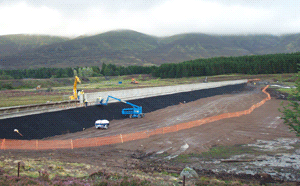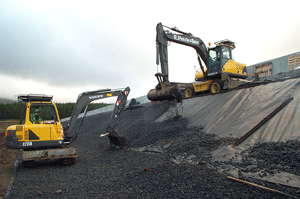Loch Ericht Refurbishment Works
Introduction

Loch Ericht straddles Perthshire and Highlands Regions in Scotland, and is a natural loch drained by the River Ericht, flowing in a southerly direction into Loch Rannoch. The loch level was first raised in 1930/31 by the construction of Ericht Dam at the south western end, and further in 1937 by the raising of Ericht Dam and construction of Dalwhinnie Dam at the north eastern end. The reservoir is now over 24 km long, is owned and operated by Scottish & Southern Energy plc, and supplies the Rannoch hydropower station as part of the Tummel Hydro Electric scheme.
Following a statutory inspection in June 2000 under the Reservoirs Act 1975, both dams were subject to more severe design flood standards, the result of which was that the freeboard and overtopping protection was inadequate. The refurbishment works included raising and extension of both dams, strengthening of the upstream and downstream faces at Dalwhinnie Dam, and improvements to the spillway basin at Ericht Dam.
The consultant for the works was Faber Maunsell, the main contractor was Morrison Construction Services and the asphalt works were carried out by specialist subcontractor Hesselberg Hydro.
Design
Dalwhinnie Dam – Upstream Face

Various options for strengthening of the upstream face were considered including rip-rap at different gradients, bituminous grouted rip-rap, and Open Stone Asphalt (OSA).
A value engineering study showed clearly in favour of the Open Stone Asphalt layer, partially to do with the significant cost savings of this option, estimated to be approximately £200k.
Dalwhinnie & Ericht Dam – Dowstream Face & Spillway Basin
Erosion protection was required to prevent damage during overtopping at Dalwhinnie and to reinforce the embankments within the spillway basin at Ericht.
In both cases open concrete blocks and in-situ Grasscrete were specified to provide the erosion protection. Hesselberg Hydro offered an alternative design using Open Stone Asphalt which provides sufficient erosion protection and a surface able to encourage the growth of plants through the material. This was important to satisfy the aesthetic requirements for the embankments.
During the works on the Dalwhinnie downstream face it became apparent that the embankment fill material beneath the topsoil was granular and quite loose. During an extended overtopping event there was concern that this material would become saturated and then unstable. To reduce the seepage of water into the embankment a layer of Lean Sand Asphalt was placed beneath the OSA.
Materials
Open Stone Asphalt
Open Stone Asphalt is a high void content gap-graded and underfilled mixture of aggregate, bound by a thick and durable film of mastic binder, which is a mix of sand, limestone filler and bitumen. The film is resistant to weathering and ageing and fixes the open skeleton of stones to withstand mechanical loads from waves and flow.
Typical stone sizes used for OSA are 20/40mm and 20/32mm but finer gradings may be used for special applications, e.g. footways. The type of aggregate is chosen carefully as the adhesion between the aggregate and bitumen is very important for the material’s long-term durability. Usually limestone is preferred over harder aggregate.
The quantity of mastic for a complete coating of the aggregate is dependent on the size, shape and surface properties of the aggregate, and the mastic’s viscosity. The viscosity of the mastic at mixing and placing temperatures is very important – too low and it will sag through the mix (segregate) and seal the filter layer below – too high and the coating of the stones may not be complete.
The void content of the placed material varies between 20 – 25%
In general OSA comprises of :
| Stone | 18 – 22% by mass |
| Mastic | 78 – 82% by mass |
The mastic comprises of :
| Sand | 55 – 66% |
| Limestone Filler | 16 – 25% |
| Bitumen (100-150 pen) | 17 – 21% |
It must be noted that the above ranges cover a wide variation in the actual raw materials available at any particular location – they are not mixing tolerances.
For each project suitable mixing plants are selected and the raw materials available are analysed. The results of the tests will determine if the materials are suitable, and if so, the actual mix design for those materials.
Lean Sand Asphalt
Lean Sand Asphalt (LSA) is a mixture of sand (96%) and bitumen (4%). The sand grading is not critical so the most readily available sand is usually used. The resulting uncompacted material has a void content of approximately 40%.
LSA is usually used as a filter layer beneath OSA revetments, but at Dalwhinnie it was used to stabilise the embankment formation and reduce water ingress. For this application limestone filler (3%) plus additional bitumen (0.8%) was added to the mixture to reduce the void content of the placed material.
Installation
Dalwhinnie Dam – upstream face (2,300 m2)
The existing upstream face consisted of concrete slabs at a slope of 1V:2H. The concrete surface was jetwashed to remove moss and any loose material from the surface. Once dried, the surface was prepared for the application of the OSA layer. Super penetration primer was applied by sprayer to the whole area followed by strips of modified bitumen to help the adhesion between the OSA and the concrete. Permatrack PSB was used in strips 1m long x 100mm wide by 15mm thick. They were warmed until tacky and then applied at a rate of 1 per 4m2.
The OSA was produced at Ennstone Thistle’s Shierglas quarry which was selected for its proximity to the works and the high quality of the limestone available at the quarry. Mixed at 140-160oC, the material was transported to the site some 25 miles away in standard insulated wagons. On site the OSA is tipped into steel open-ended skips which minimise wasteage and can be covered to retain heat.
The OSA is loaded from the delivery skips into site dumpers by JCB, then taken to the working area where it is tipped into another open-ended skip.
A 360o excavator at the toe of the slope takes the material from the skip and places it on the upstream face. The finished layer was profiled to a uniform depth of 250mm on a slope length of up to 8m, along the entire length of the dam which is 330m.
The joint between the OSA and the crest was filled with hot-poured bituminous mastic. At the toe, the asphalt was formed at an angle of 45o and this exposed edge was reinforced with hot-poured bituminous mastic, placed at a rate of 10 kg/m.
Dalwhinnie Dam – downstream face (4,500 m2)
The existing downstream face consisted of a granular embankment covered with topsoil and vegetation. The topsoil was stripped down to the granular material then OSA was placed over the area on a geotextile filter layer. The placing method was similar to the upstream works but with two excavators – one at the toe and one at the crest.
The crest road and the lower section of the slope were covered with 125mm OSA whilst the top section of the slope was covered with a 100mm layer of OSA. The LSA layer beneath the geotextile on the higher sections was placed at 50-60mm thick over the crest and upper parts of the slope.
Ericht Dam – spillway basin (900 m2)
The works at Ericht dam consisted of protecting slopes adjacent to the spillway structure, protection of the crest road at both ends of the dam, and lining of a drainage channel to take water from the crest down to the basin.
The works were executed with a long-reach excavator placing a 125mm layer of OSA on geotextile.
Over the whole of the asphalt works over 2,500 tonnes of asphalt were used.




